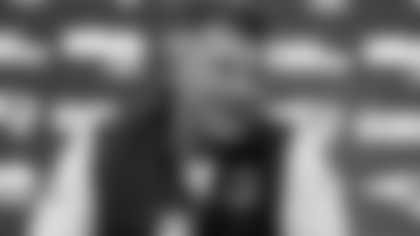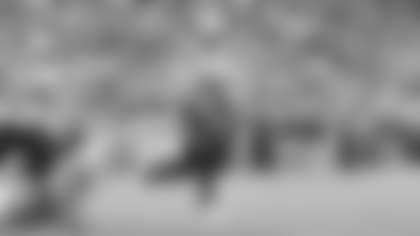The big talking point following Sunday's loss to the Seahawks is that the Patriots offense needs to find a downfield passing game to get back on track Thursday night vs. the Jets.
New England has a short week to correct the issues preventing them from pushing the ball downfield more through the air. Through two weeks, QB Jacoby Brissett has thrown for 270 passing yards on 5.3 yards per attempt. Brissett is one of four starters who haven't completed a deep pass (20+ yards), with an average target depth that ranks 24th out of 31 qualified quarterbacks (6.7 yards). Brissett's longest pass completion was 14 air yards, while only a third of his passes have traveled past the sticks.
"We've got to find a way to get the ball down the field. We've got to find a way to get the ball in our playmakers' hands so those guys can get out there and make yards," head coach Jerod Mayo said on Monday.
Although the passing offense's limitations are clearly a problem, is it a Patriots-only issue or a league-wide trend? In the first two weeks, the NFL is averaging just over 190 passing yards per game. Despite his limited production, Brissett is tenth in QBR and smack-dab in the middle in expected points added per drop-back (15th, +0.05). From an efficiency standpoint, Brissett has been around or slightly above league average.
On a positive note, the Patriots offense has boasted one of the league's best rushing attacks through the first two weeks. New England ranks eighth in expected points added per rush and fourth in total rushing yards (355). On Sunday, the Pats got their zone runs going with a good mix of outside zone, split-flow zone, and zone windback plays while utilizing more motion.
Despite a potent run game, the Patriots haven't been successful in play-action passing, which, again, is a league-wide problem so far this season. Due to influences from the Fangio system and other coaching trees, defenses are playing two-deep safety shells at an all-time high. The idea is for defenses to turn quarterbacks into check-down artists while also forcing offenses to run the ball rather than open up their passing game.
Specifically to New England, the Patriots offensive line is also having issues in pass protection, which limits their ability to push the ball downfield. The Pats have allowed the second-highest pressure rate in the NFL through two weeks at 44.3%, per NextGen Stats. Here are two examples of where the Patriots are coming up short in the passing game:
In this first clip, the Pats are running a West Coast staple called "Leak," a designed shot play sequenced off the running game. The play is designed to sell a hard fake to get the defense flowing in one direction while sneaking the tight end (Y) out of the backside of the formation.
The Patriots use all sorts of window dressing to get the defense to bite on the fake, bringing speedy receiver DeMario Douglas in motion and pulling the right guard to simulate a gap play. Unfortunately, the protection doesn't hold up long enough for Brissett to hit TE Hunter Henry in stride. From this perspective, the breakdown happens because Henry goes out on his route a beat early, while rookie RG Layden Robinson looks uncertain of his assignment as the puller. Henry would've had a walk-in touchdown on an explosive play if the blocking held up.
Another issue the Patriots are having with their play-action plays is that defenses are anticipating when they're going to take a shot and playing two-deep safety coverages. Again, this is something we're seeing more of around the NFL and might not be specific to the Patriots.
Here, the Patriots are running a two-man route concept where they anticipate getting a single-high safety with heavy personnel on the field and the QB under center. The deep post pattern is supposed to put the post-safety in conflict, where he can either clamp down on the intermediate route or stay on the post. Instead, the two-deep safety zone completely covers both downfield routes, and Brissett scrambles for a short gain.
In this week's audio breakdown, we also discussed some timing/anticipation issues with the Patriots passing game. Brissett made a few nice off-script plays and showed good processing speed on his touchdown pass to rookie WR Ja'Lynn Polk. However, there's still some hesitation in letting the ball fly and attack tight windows downfield. Brissett has the third-highest average time to attempt through two weeks (2.89s). Some of that is because he's extending plays while under pressure, or his receivers aren't uncovering, but it also speaks to him holding the ball sometimes.
The Patriots struggles feel different from the rest of the league because we anticipated them being a limited passing attack. However, the bottom line is that defenses are suffocating passing offenses that we expected to be elite in the early going. Some of that might be because of limited contact practices and preseason games for starters these days.
With timing and trust between teammates being key, passing around the entire NFL is down through the first two weeks. For the Patriots, the question is whether the personnel is capable of figuring it out offensively.
Here is a breakdown of the Patriots defense and quick-hit film notes from Sunday's loss to the Seahawks After Further Review:
How Seahawks QB Geno Smith and OC Ryan Grubb Out-Dueled the Patriots Defense
Coming off their opening-week win, the Patriots defense earned their flowers by shutting down Bengals QB Joe Burrow, allowing 10 points and -0.04 EPA per drop-back in a Week 1 victory.
You deserve praise when you limit one of the NFL's best quarterbacks. However, the spin-the-dial defense head coach Jerod Mayo and defensive coordinator DeMarcus Covington are running has a boom-or-bust factor that their predecessor didn't fully subscribe to defensively. That's not to say the Pats didn't disguise coverage and utilize an exotic third-down package under former coach Bill Belichick because they most certainly did. But, from this perspective, there's more risk taking in the Covington/Mayo scheme than Belichick's defense.
Belichick's defenses were about discipline, structure, and, frankly, simplicity. They were a post-safety defense that consistently was among the league leaders in man coverage rate. Belichick was one of the pioneers of divider leverage in man coverage, where primary coverage defenders would play off their help, and the hallmark was that they seldom beat themselves.
Belichick's defenses were sound, but despite a reputation for being a mad scientist, New England wasn't overly complicated from a scheme standpoint. Now, the coverage rotations, disguising, and different match principles they're running in the secondary are complex. Last week, the Boston Herald's Andrew Callahan reported the Patriots installed elements from Seahawks coach Mike Macdonald and the Ravens exotic defense.
After Week 1, we praised the coaching staff's plan against Cincinnati. On Sunday, Seahawks quarterback Geno Smith and offensive coordinator Ryan Grubb caught the Patriots defense in some trickery that led to big plays for Seattle. Obviously, we know about the 56-yard touchdown to star receiver DK Metcalf, but that wasn't the only coverage breakdown or instance where Seattle was a step ahead of New England.
Along with catching the Patriots in some of their coverage wrinkles, New England is overly reliant on scheming up pressure. According to NextGen Stats, the Patriots are 31st in total pressure rate (24.1%) and dead last in pressure rate without blitzing (16.9%). Without star pass-rusher Matthew Judon (traded to ATL) and stud DT Christian Barmore (blood clots), the pass rush has not been productive enough in the first two weeks (besides Keion White). Although scheming pressure can work well sometimes, it led to some issues that the Seahawks exploited where the Patriots were putting players in unfamiliar spots or didn't have the proper structure.
For example, the Patriots are showing a zero blitz structure before the snap on the third down play below. The idea is to simulate pressure to stress the protection into allowing free runners.
However, Smith beats it with great quarterbacking. First, the pre-snap shift by Smith-Njigba gives Smith an indicator that the pressure is coming from the safeties on the right side. Geno checks the Seahawks into a seven-man protection to pick up the blitz and works between the numbers against middle of the field open. With Keion White and Joshua Uche dropping into the cover two zone, the Pats pass-rushers are in tough spots in deep zone drops, and Smith makes a great throw to hit JSN between two defenders who typically rush the passer.
The other challenge to scheming pressure is that it's sometimes difficult to keep the quarterback in the pocket with an aggressive approach in the pass rush.
Here, the Patriots run a three-man game to the right side of the line that occupies the center, right guard, and right tackle. The scheme works to produce a free runner as LB Raekwon McMillan blitzes up the middle unblocked. However, with man coverage behind it, Smith gets out of the pocket because the Pats lose the edge. Once he extends the play, Metcalf uses a subtle push-off to create separation as he works back toward his quarterback for a 14-yard gain.
Lastly, Patriots CB Jonathan Jones was fair to be critical of the officials calling a 20-yard defensive pass interference in overtime. But the Pats still had a third-and-6 from just outside field goal range that could've gotten them off the field. On the play, the Seahawks catch the Patriots with a scheme called "mesh traffic" against man coverage. With the crossers working the middle of the field, the idea is to sneak the running back out of the backfield while his man coverage defender has to track him across the field.
New England appears to be in another man-blitz coverage, and when Seattle motions the back into the backfield, the Patriots might've anticipated that RB Zach Charbonnet would stay in to block, so S Jabrill Peppers converts to a blitzer to overload the protection. Instead, Charbonnet runs an arrow route into the flat that the Patriots didn't anticipate, and nobody covers Charbonnet. It's a coverage bust, and the Seahawks running back converts to essentially win the game.
In their upset win over the Bengals, the Patriots defense won the chess match against Cincinnati. However, on Sunday, the Seahawks won the schematic battle. Seattle caught New England in their exotic blitz pressures and out-foxed them with the game on the line in overtime.
Simply put, the Patriots got out-coached. Now, they must determine if the breakdowns are easily fixable with more time in these fresh schemes or if they want to go back to basics.
Quick-Hit Film Notes From Patriots-Seahawks After Further Review:
Offense
- Three theories about WR DeMario Douglas's slow start: one is usage-related, one is scheme-related, and one is quarterback related. First, with a long season ahead, the Pats might be pacing Douglas to keep him healthy. Second, out of 20 snaps in 12 personnel, Douglas was only on the field for two plays. The coaching staff doesn't view the 180-pound receiver as a base receiver in a run-first offense, favoring sturdier blockers Ja'Lynn Polk and KJ Osborn. Besides putting him in motion, there isn't much else he can do in their base offense.
Lastly, Brissett said several times during the camp that he was adjusting to throwing to a receiver with Pop's build. Brissett is not starting his progression on Douglas often, so it's possible that he feels more comfortable throwing to guys with larger catch radiuses. Douglas is getting open on film, so it's understandable if he's frustrated with his lack of targets. But a combination of those factors and possibly something unforeseen is keeping him out of the mix.
- TE Hunter Henry's career day mostly came in the first half, when he found soft spots in zone coverage. Out of his career-high 109 yards, 98 came in the first half, while 82 yards were against zone. That said, Henry also won twice vs. man coverage on third down, running a nice crosser against a man-free defense for an easy conversion. Henry's the one receiver Brissett trusts in the passing game: the Pats QB1 and TE1 connected on several leverage/anticipation routes that showed their growing chemistry.
- RB Antonio Gibson was great with a 45-yard run, gaining 51 rushing yards after contact. That play had no chance with the puller being late to kickout the edge rusher, and Gibson somehow got out of it, had two more guys bounce off him, and then burst to daylight. Gibson also caught a third-down catch on a curl-flat concept for a first down. Gibson's ability to make yards as a sub-package back was on full display.
- RB Rhamondre Stevenson ground out some tough yards on outside zone and the Pats downhill run concepts. The G-Lead play on the goal line with Stevenson in the wildcat was a nice wrinkle, too. Stevenson continues to have a huge workload, which is something they'll need to monitor, but he has been excellent through two weeks as the Pats lead-back.
- RT Mike Onwenu struggled with four QB pressures allowed including a QB hit and a hurry that led to a sack. Onwenu also let the edge defender backdoor him on an outside zone run stuff. Onwenu was playing with a short corner because he was consistently opening his hips early, shortening the path to the QB. Tackles typically do that when they feel threatened by speed rushers and don't trust their foot speed. Onwenu's footwork issues can be corrected, but he's built like a guard, and that limits his movement skills when he's on an island in pass protection. This tape was toward the weaker end of the spectrum for Onwenu, but it's not abnormal for him to have pass pro issues at right tackle.
- Rookie RG Layden Robinson allowed a sack and two hurries in pass protection but had some standout run blocks, especially on Gibson's 19-yard outside zone run. Robinson plays through the whistle with excellent play strength. However, he gets too aggressive in his pass sets and needs to refine his hand technique to secure blocks and keep guys from getting on his edges. Overall, Robinson plays with force in the run game and has a stout anchor – you'll take that.
- LT Vederian Lowe sustained a knee injury in the game while tying for the team-high four quarterback pressures (QB hit, three hurries). Lowe can use his length and a solid anchor to hold up on the left side, but quick changes of direction cause him to lose his technique. When he's asked to mirror twitchy edge rushers like Boye Mafe, his feet get stuck sometimes when those guys give him an inside fake and burst outside to corner the edge.
- Rookie WR Ja'Lynn Polk found the end zone for the first time in his short NFL career on a nice skinny on a double-post concept. Polk was also open on the first third down of the game, but Brissett didn't pull the trigger on the backside dig route. Polk gets open vs. zone and from the slot vs. man. But he needs to threaten defenders more in his stems when he gets off-coverage on the outside.
- Pressures allowed: Lowe (QB hit, three hurries), Onwenu (QB hit, three hurries), Robinson (sack, two hurries), Jordan (sack), Andrews (two hurries), Hooper (hurry).
Defense
- I've watched the Metcalf TD several times and have settled on assigning half-blame on Dugger and Gonzalez each. Dugger took responsibility after the game, saying he checked into the call, but if you look at the other side of the formation, the two DBs play it like match quarters. I'll say this without knowing the exact call: I don't know of a "max" coverage call where you don't match verticals. Gonzalez is lined up over Metcalf, who runs a vertical, and he just lets him go. Usually, if you're playing match coverage, you pass off under routes and play verticals like it's man coverage. I'll say this part II: this is also the risk you run when you get too cute with your disguises. Gonzalez is an outside corner playing inside and Dugger is a safety playing the boundary. Neither Pats defender is in a spot they're accustomed to being in, and it's a coverage bust for a 56-yard touchdown — not ideal.
- Keion White's breakout season continued with a stellar performance. White had a team-high five pressures with two sacks and three hurries. His inside slap-rip move was a go-to this week, using it to beat C Connor Williams for his full sack. White also dented the edge by pressing the tight end into the backfield on the Pats fourth-down stop. White's breakout has been fun to watch, and the main reason for it is that he's diversifying his pass-rush toolbox nicely.
- CB Christian Gonzalez lined up over star WR DK Metcalf on 36 routes, 14 in man coverage, and allowed three catches for 24 yards on seven targets and a drop. As mentioned, half of Metcalf's 56-yard touchdown fell on Gonzo. However, Gonzalez was competitive in his man reps against Metcalf, who had a drop but also got away with a subtle push off on a 14-yarder. Metcalf's size and physicality were a tough matchup for Gonzalez, and he mostly did well. The mable coverage where he was locked into Metcalf in man-to-man was great coverage on a go ball. He's on an island with the rest of the defense in cover-3 and suffocated Metcalf.
- This was another roller coaster ride for S Kyle Dugger, who was one-half of the bust on the Metcalf TD. However, he also had a sack on a well-timed blitz and blew up a perimeter screen for a TFL. If he was the primary signal-caller without LB Ja'Whaun Bentley (shoulder), the third-down conversion in overtime that essentially ended the game was another busted coverage. Dugger's coverage is inconsistent, but they need the splash plays right now.
- Besides White, the only other consistent source of pass rush for the Patriotst is EDGE Joshua Uche. Uche logged three hurries with a quick wrap on a T/E stunt, a speed-to-power rush, and a straight speed move. Uche's explosiveness is there making him tough to block in the pass rush.
- The Patriots need to find more playing time for DE Deatrich Wise (39% of defenisve snaps). Despite playing a limited role, Wise logged two pressures, and his bull rush caused Smith to under throw Metcalf on what would've been another long TD. The Pats are playing a lot of their 2-4-5 defense with bigger DTs on the interior, leading to snaps for Ekuale (77%) and Pharms (34%) that are cutting into Wise's playing time. It's not performance based.
- DTs Jeremiah Pharms and Daniel Ekuale are in a competition to be the other interior defender playing next to NT Davon Godchaux in their base fronts. On Sunday, Pharms got the edge, logging two run stuffs, a QB hit (stunt), and a hurry. Pharms absorbing a double-team on the Pats fourth-down stop will get him more playing time. Conversely, Ekuale went over the top on a third-and-1 run that had a soft interior and was easily picked up by Seattle.
- CB Jonathan Jones lined up over WR Tyler Lockett on 25 routes and held Lockett to one catch for 16 yards into his coverage. Jones was mostly great on Lockett, and the 20-yard DPI in overtime was a tough call in that spot. Jones was the Patriots best CB on Sunday.
- CB Marcus Jones drew the assignment on WR Jaxon Smith-Njigba in man coverage situations, shadowing JSN on 22 routes. Smith-Njigba caught four passes for 42 yards on seven targets vs. Jones with a drop. Most of JSN's damage came against zone coverage.
- S Jaylinn Hawkins made a nice play on his first-half pass breakup on third down. Hawkins was playing a half-field safety role in cover two, and Seattle ran a dagger concept to clear out the window for JSN to run an in-breaker. Hawkins read it well and broke on the ball immediately. Otherwise, that would've been a first-down completion. Hawkins was also step-for-step on a third-down crosser in man coverage on TE Noah Fant. He's settling into his role.
- LB Raekwon McMillan filled in for injured LB Ja'Whaun Bentley (shoulder). McMillan logged two hurries on interior blitzes (schemed) but missed a tackle at the line of scrimmage on Seahawks RB Zach Charbonnet that ended up being a five-yard gain. McMillan doesn't look out of place when he's in on defense. However, it seemed they missed Bentley's signal-calling.
- NT Davon Godchaux and edge-setter Anfernee Jennings continue to do their thing against the run: Godchaux eating double-teams and Jennings setting a sturdy edge. They have the Patriots run defense off to a solid start this season.
- QB pressures: White (two sacks, three hurries), Dugger (sack, hurry), Uche (three hurries), Pharms (hit, hurry), Jennings (QB hit), McMillan (two hurries), Wise (two hurries), M. Jones (hurry), Tavai (hurry), Godchaux (hurry), Peppers (hurry). Run stuffs: Pharms (two), Jennings (two), Dugger/White/Ekuale/Godchaux/Wise/Peppers (one).
- Coverage: Dugger (6/6/77 yards, TD), M. Jones (10/7/63 yards/PBU), Tavai (5/5/53 yards), Gonzalez (8/5/31 yards/PBU), White (2/2/31 yards). J.Jones (3/3/27 yards/DPI), Wilson (1/1/16 yards/DPI), McMillan (1/1/10 yards), Uche (1/1/9 yards), Jennings (1/1/7 yards), Peppers (2/1/3 yards), Hawkins (2/0/PBU).
DISCLAIMER: The views and thoughts expressed in this article are those of the writer and don't necessarily reflect those of the organization. Read Full Disclaimer










































